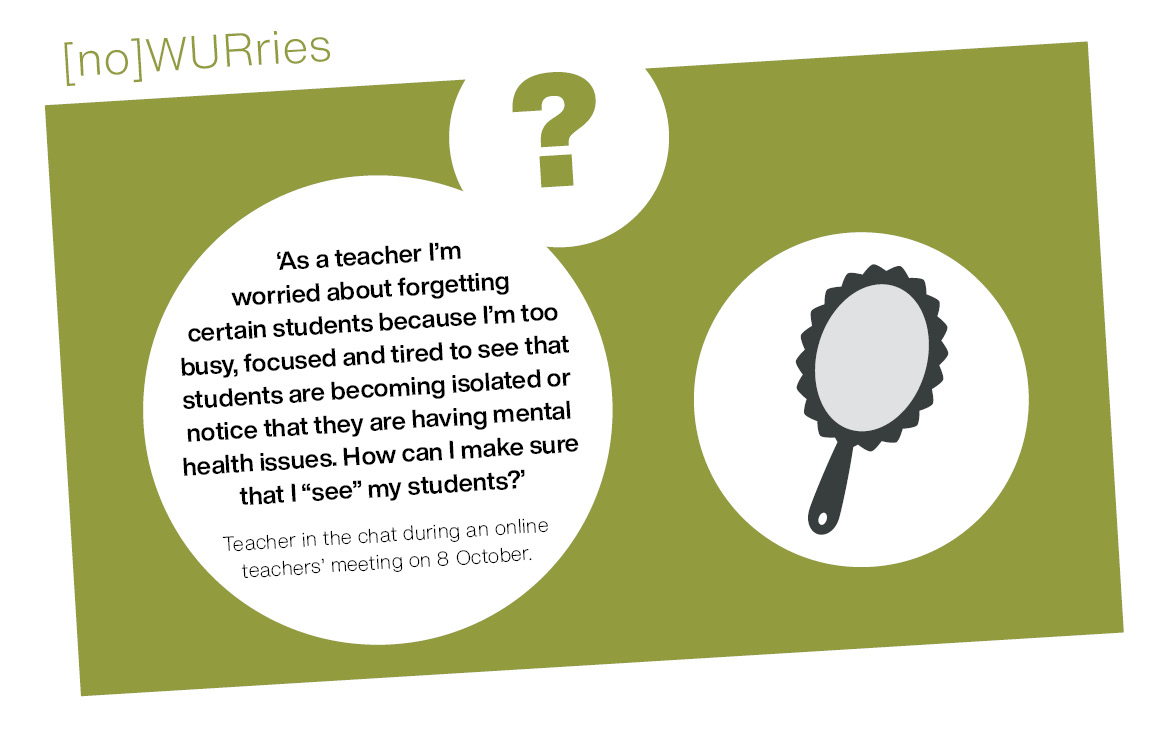‘As a teacher I’m worried about forgetting certain students because I’m too busy, focused and tired to see that students are becoming isolated or notice that they are having mental health issues. How can I make sure that I “see” my students?’ Teacher in the chat during an online teachers’ meeting on 8 October.
Appointments
Last summer, I sometimes arranged appointments in the garden to chat to students at a safe distance from one another. That was much more personal than all those video conversations and less tiring too. It was great to be outdoors in the sun with tea and biscuits, or even a beer at the end of a day. You inevitably get to hear more that way. That’s no longer possible so I’m back to video chats, preferably short and frequent. How students are doing is sometimes half the conversation. In one project, we also created a Teams group so students and supervisors interact in between times too.
Patrick Jansen, associate professor of Wildlife Ecology and Conservation
Be there
If you are in charge of a large group of students, it’s impossible to keep an eye on all of them. So make sure the students on the course can see you! Make sure you have regular contact with your students via various channels (email, Brightspace) and that you are visible in all online activities, even when other teachers are lecturing. Of course it’s nice if you can manage some live contact moments as well.
Ute Sass-Klaassen, assistant professor of Forest Ecology and Forest Management
Approachable
Make sure from the start that you are approachable if students want to discuss their problems. Let it be known that they don’t need to be ashamed of this and teachers are struggling too with these challenges. If relevant, you could give a personal example. You could also incorporate brief practical assignments, polls or update sessions that let you see who might be having trouble keeping up.
Lysanne Snijders, assistant professor of Behavioural Ecology
Hybrid
Teaching under the Covid restrictions means both teachers and students have less feeling with the material and the group. It would help hugely if a course could be given in a hybrid form: the difference between zero live contacts on campus and one live contact is immense. I also advise teachers to take time to explicitly discuss with students how things are going, whether in the virtual classroom sessions or outside them. It will still be a question of muddling along, but you should at least discuss everyone’s experiences and expectations. Things that are self-evident offline often need explicit attention online.
Geert van Zandbrink, Economics and Policy student
Go crazy
Make your lectures interactive! That will make it worthwhile for the students to be there for the live version. Don’t just discuss the course material; use the time as well to encourage the students to connect to one another, have a good laugh with them or go crazy. Ask where the students are sitting right now, what the weather is like and so on. That will make us feel more involved and ‘seen’ and we’re also more likely to speak up. It’s fine too for teachers to point out that the workload has increased immensely and it’s difficult for them to see how students are doing.
Bob Ter Haar, Organic Agriculture Master’s student
Next WURrie
I have a question I’d like to ask anonymously. The person who lives in the room above apparently has their bed next to the radiator. Given that radiator pipes conduct sound very well, I am sometimes kept awake at night by the ‘rhythmic clunking’ of the bed against the radiator. How can I raise this issue with my upstairs neighbour without being too direct? Student S. (name known to the editors)
If you have advice or tips for this Wurrier, send an email (max. 100 words) before 18 November to resource@wur.nl with subject ‘noWURries #7’. If you need advice yourself, email your problem (max. 100 words) to resource@wur.nl with subject ‘noWURries’.

